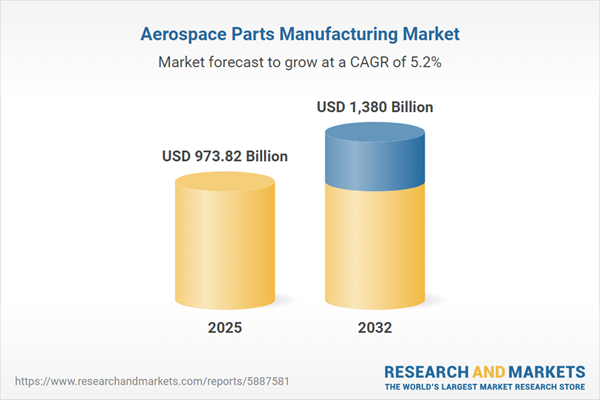Speak directly to the analyst to clarify any post sales queries you may have.
Senior executives managing aerospace parts manufacturing are contending with increasing complexity, changing regulatory frameworks, and rapid technological evolution. Navigating these shifts demands precise, data-backed strategies aligned with the nuances of today’s global market environment.
Aerospace Parts Manufacturing Market Snapshot
The aerospace parts manufacturing market attained a value of USD 925.13 billion in 2024, with a forecasted rise to USD 973.82 billion in 2025 and an expectation to surpass USD 1.38 trillion by 2032, reflecting a compound annual growth rate (CAGR) of 5.19%. This steady trajectory demonstrates the sector’s resilience and shows how investment in digital transformation, material innovation, and advanced production processes continues to shape a competitive environment. The industry focus extends to ensuring operational excellence, adhering to evolving international standards, and efficiently responding to the unique requirements of both commercial aviation and defense segments across a broad spectrum of global markets.
Scope & Segmentation of the Aerospace Parts Manufacturing Market
This report delivers a comprehensive view of key influences guiding strategic priorities and capital allocation within aerospace manufacturing. Market segmentation highlights core operational areas and competitive differentiators essential to market participants:
- Product Types: Avionics, engines, combustion components, compressors, exhausts, turbines, fuel and hydraulic systems, interiors, landing gear, and structural modules directly impact manufacturing dependability and overall output efficiency.
- End Use: Maintenance, repair, and overhaul (MRO) services extend operational lifecycles, while original equipment manufacturing (OEM) enables continuous adoption of innovative tech within fleets.
- Metals: Choices include aluminum alloys to reduce mass, nickel and titanium for demanding environments, and steel for applications with high mechanical stress.
- Composites: Incorporates aramid, carbon fiber, and glass fiber, providing durability, lighter weight, and adaptability for longer service intervals and broader usage potential.
- Geographies: The Americas, Europe, Middle East and Africa, and Asia-Pacific each drive specific regional approaches—capacity expansion, regulatory focus, automation, and research-led initiatives all feature prominently.
- Key Companies: Major sector leaders include Raytheon Technologies Corporation, General Electric Company, Safran S.A., Rolls-Royce plc, Honeywell International Inc., Parker-Hannifin Corporation, MTU Aero Engines AG, Leonardo S.p.A., GKN Aerospace Limited, and Triumph Group, Inc. These companies model best practices in technology integration, compliance, and performance standards for peers and new entrants.
Aerospace Parts Manufacturing Market: Key Takeaways
- Digitalization is strengthening visibility and synchronization between shop floor operations and executive-level decision-making, creating greater responsiveness and product quality.
- Material and design advances support stringent cost controls and contribute to more sustainable practices throughout production and lifecycle management.
- Supplier collaborations and nearshoring are building supply chain strength and agility, enabling a robust response to unpredictable market or political shifts.
- Distinct regional strengths drive sector performance; Asia-Pacific advances capacity, the Americas focus on automation projects, and EMEA accelerates research and development in propulsion and electrification.
- Partnering between OEMs and local organizations enhances compliance outcomes and increases the effectiveness of technology implementation projects.
- Targeted workforce upskilling ensures readiness for new digital tools and analytical tasks, helping organizations adapt to the rapid pace of market evolution.
Tariff Impact: Navigating 2025 United States Trade Actions
With anticipated changes in U.S. trade policy, leaders overseeing procurement must maintain awareness of tariff restructuring and its potential effects on sourcing and supplier diversity. Adapting internal risk management protocols and compliance frameworks will be critical for supporting uninterrupted production as tariffs and regulations change.
Methodology & Data Sources
The insights in this report draw upon structured interviews with aerospace sector executives, cross-referenced with up-to-date technical and regulatory sources. Quantitative modeling validates the analysis, delivering actionable intelligence for senior leaders.
Why This Report Matters for Aerospace Parts Manufacturing
- Equips decision-makers with relevant and current market intelligence for procurement, digital transformation, and supply chain optimization.
- Fosters stronger risk mitigation and flexible responses to evolving regulations or industry shifts.
- Serves as a reliable reference point for benchmarking, supporting continued alignment with global standards and compliance requirements.
Conclusion
This report distills complex sector dynamics into insight executives can use to guide planning and sustain operational resilience in a dynamic aerospace manufacturing marketplace.
Additional Product Information:
- Purchase of this report includes 1 year online access with quarterly updates.
- This report can be updated on request. Please contact our Customer Experience team using the Ask a Question widget on our website.
Table of Contents
3. Executive Summary
4. Market Overview
7. Cumulative Impact of Artificial Intelligence 2025
Companies Mentioned
The companies profiled in this Aerospace Parts Manufacturing market report include:- Raytheon Technologies Corporation
- General Electric Company
- Safran S.A.
- Rolls-Royce plc
- Honeywell International Inc.
- Parker-Hannifin Corporation
- MTU Aero Engines AG
- Leonardo S.p.A
- GKN Aerospace Limited
- Triumph Group, Inc.
Table Information
| Report Attribute | Details |
|---|---|
| No. of Pages | 198 |
| Published | October 2025 |
| Forecast Period | 2025 - 2032 |
| Estimated Market Value ( USD | $ 973.82 Billion |
| Forecasted Market Value ( USD | $ 1380 Billion |
| Compound Annual Growth Rate | 5.1% |
| Regions Covered | Global |
| No. of Companies Mentioned | 11 |









